Fungi Identification in American Forests: A Complete Guide
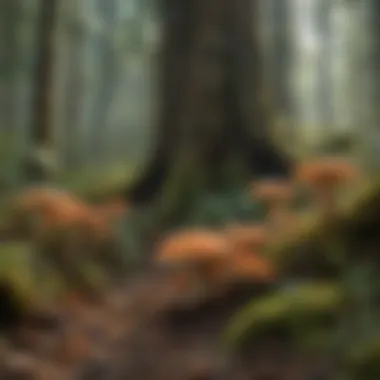
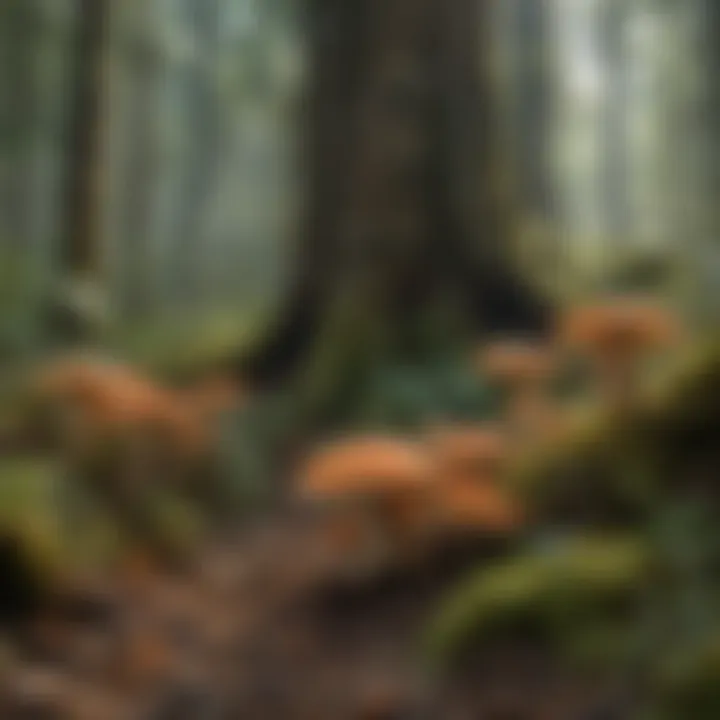
Intro
Fungi play a pivotal role in the ecosystems that blanket America's forests, serving as both allies and adversaries to the diverse array of flora and fauna. Yet, the act of identifying these organisms can be a daunting task. With over ten thousand species documented just in North America, the intricacies of taxonomy and the subtle nuances that differentiate one type of mushroom from another can quite literally throw a wrench into any enthusiast's plans. This guide aims to shed light on the complexities tied to fungi identification, aiding both the curious novice and the seasoned expert.
The approach involves a detailed examination of different fungal species, an exploration of classification methods, and pragmatic identification techniques that will enhance your understanding of fungi. In addition, it discusses the significant ecological functions of fungi—whether it’s facilitating nutrient cycling, forming symbiotic relationships, or serving as natural indicators of environmental health. Fungi’s role cannot be overstated, and an understanding of their identification contributes considerably to forestry practices and environmental conservation.
As misidentifications can lead to detrimental ecological consequences as well as potential health risks, mastering the art of fungus identification is both a responsibility and an opportunity for enthusiasts and professionals alike. This comprehensive guide aims to elevate your knowledge, offering insight into the fascinating world of fungi, their ecological contributions, and how you can identify them in the wild.
Understanding Fungi
Fungi play a pivotal role in the intricate tapestry of life on Earth. They are not just a simple part of the ecosystem; rather, they form an essential component that influences the survival and health of numerous species, including plants, animals, and humans. Understanding fungi is critical for forestry professionals and ecologists alike, as it offers insights into biodiversity, ecosystem health, and even agricultural practices.
Fungi's unique biological characteristics set them apart from plants and animals. They belong to their own kingdom, distinct in their cellular composition and growth patterns. This distinction is vital in understanding their wide-ranging impact. One of the most significant aspects of fungi is their role in decomposing organic matter, which enriches the soil and facilitates nutrient cycling. Without this natural recycling process, ecosystems would accumulate dead organic material, failing to support plant and animal life effectively.
"Fungi serve as nature's recyclers, breaking down complex organic materials into simpler compounds that nourish the soil."
Fungi exhibit diverse forms that serve various purposes. From the familiar mushrooms that dot forest floors to microscopic molds involved in fermentation and decay, the spectrum of fungal life is extensive. This diversity not only aids in understanding ecological relationships but also promotes the discovery of potential applications in medicine and food production.
Fungi are also known for their unique symbiotic relationships, particularly with plants. Mycorrhizal fungi enhance water and nutrient uptake in plants, while plants provide the fungi with carbohydrates. This mutualistic partnership is vital for plant health and productivity.
In summary, understanding fungi involves recognizing their ecological functions, diversity, and the invaluable services they provide in forest ecosystems. For professionals in forestry and ecology, such comprehension is not merely academic; it forms the foundation for effective forest management and conservation strategies. The deeper one digs into the world of fungi, the more the interconnectedness of life becomes clear, emphasizing how pivotal these organisms are in sustaining life on our planet.
Fungi in the Ecosystem
Fungi are often regarded as the unsung heroes of the ecosystem. Their contribution goes beyond mere decomposition; they interact with myriad organisms and environments in fascinating ways. Fungi act as decomposers, breaking down dead organic matter, which culminates in a healthier soil composition. They liberate nutrients that would be otherwise trapped in complex materials, thereby fostering plant growth and contributing to a vibrant ecosystem.
In addition to decomposition, fungi establish mutually beneficial relationships with plants through mycorrhizae. This symbiosis not only improves nutrient absorption for the plants but also allows fungi to access carbohydrates from their hosts. This dual exchange exemplifies the intricate balancing act present in ecosystems, where various life forms work together, enhancing resilience against environmental stressors.
The impact of fungi extends to influencing food webs. As primary decomposers, they create a foundation on which other organisms depend. Without fungi, primary producers would struggle to flourish, setting off a chain reaction that could ultimately threaten biodiversity.
Diversity of Fungal Species
The diversity of fungal species is truly staggering. Estimates indicate that there might be over a million distinct fungal species, with new ones being discovered regularly. This vast array encompasses a wide range of forms, from multicellular mushrooms to single-celled yeasts.
- Macrofungi: Visible to the naked eye, these include mushrooms, puffballs, and bracket fungi. They come in an astonishing variety of shapes and colors, adapting to different environments and ecological niches.
- Microfungi: Often overlooked due to their minute size, these fungi can be found on decaying organic matter or as parasites on other plants. They are crucial for processes like fermentation and antibiotic production.
- Lichens: A unique partnership between fungi and algae (or cyanobacteria), lichens can thrive in the most inhospitable environments, demonstrating the adaptability of fungi.
- Pathogenic fungi: Some fungal species can be harmful to plants and animals, showcasing the dual nature of fungi as both beneficial and detrimental organisms.
The ecological roles fungi occupy shape their interactions with other organisms and the environment. Their ability to adapt and thrive in diverse habitats illustrates their evolutionary prowess and emphasizes the importance of studying these organisms extensively. By understanding the variety of fungal life, scientists and practitioners can comprehend ecosystems more holistically, paving the way for informed conservation efforts.
Importance of Fungi in American Forests
Fungi play a fundamental role in maintaining the health and stability of American forests. They are not merely organisms lurking beneath the forest floor; they are dynamic players in the ecosystem, contributing to nutrient cycling, forming intricate relationships with plants, and fostering biodiversity. Understanding their importance is crucial for forestry professionals and anyone with an interest in preserving these vital environments.
Nutrient Cycling
Fungi serve as nature's recyclers. They break down organic matter, such as dead plants and animal matter, turning it into nutrients that are essential for the growth of other organisms. This process is critical not just for soil health, but also for the overall productivity of the forest. Without fungi, decomposition would slow down significantly, leading to nutrient depletion and an inability for plants to thrive.
Key Functions of Fungi in Nutrient Cycling:
- Decomposers: Fungi are primary decomposers of complex organic materials like lignin and cellulose. Their enzymes break these substances down into simpler compounds that can be reused by plants.
- Soil Structure Improvement: The mycelium of fungi contributes to soil formation and structure by creating aggregates in the soil. This enhances aeration, water retention, and nutrient availability.
- Nutrient Availability: Fungi help increase the bioavailability of nutrients such as nitrogen and phosphorus. Mycorrhizal fungi, which associate with plant roots, extend the root system's reach, allowing plants to access hard-to-reach nutrients.
"Fungi are nature's utmost recyclers, ensuring that life continues to flourish even amidst decay."
Symbiotic Relationships
Fungi engage in intricate symbiotic relationships, which are vital for the health of forest ecosystems. Mycorrhizal associations, for example, represent one of the most significant partnerships in forest biology. In this relationship, fungi partner with plant roots, providing essential nutrients in exchange for carbohydrates. This mutualistic arrangement enhances the survival and growth of both fungi and plants.
Notable Aspects of Symbiotic Relationships:
- Mycorrhizal Fungi: They colonize plant roots and expand the root’s surface area, greatly enhancing the plant's nutrient and water uptake capabilities. This interaction fosters stronger, healthier plants that can better withstand stressors in their environment.
- Facilitating Plant Communication: Evidence suggests that fungi can serve as conduits for communication between plants, allowing them to share resources and information about environmental conditions. This interconnectedness contributes to the stability of the forest.
- Biodiversity Support: Fungal diversity in forests promotes plant biodiversity by allowing different species to coexist. The unique nutrient requirements of various fungi can support a wide range of plants, leading to richer ecosystems.
In summary, fungi are not just a secondary player in forest ecology; they are the backbone of healthy ecosystems in American forests. Their roles in nutrient cycling and symbiotic partnerships reveal why understanding and preserving these remarkable organisms should be a priority for forestry professionals and conservationists alike.
Techniques for Fungus Identification
Identifying fungi is more than just a recreational hobby; it holds significant importance for environmental conservation and research. Understanding how to properly identify different fungi is essential for several reasons. Firstly, the ecosystem services provided by fungi are vital, ranging from nutrient cycling to habitat construction. Misidentifying a fungus can lead to ecological imbalances, and might also have dire consequences for human health if edible mushrooms are confused with toxic ones. This guide focuses on various techniques essential for accurate fungus identification, emphasizing morphological characteristics and microscopic examination.
Morphological Characteristics
Fungi exhibit a variety of morphological features that can help in identification, each contributing uniquely to the overall goal of distinguishing between species. These traits are observable in the field and often provide immediate clues about the identity of a specimen.
Cap Shape and Color
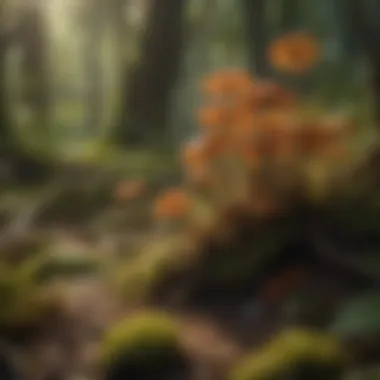

Cap shape and color are among the first things one notices when encountering a fungus. The cap can be flat, conical, or even umbrella-shaped. Color can range from vibrant reds to muted browns. This variety aids significantly in identification. A bright red cap, for example, may point towards a Lactarius or Amanita species, both of which can be easily spotted in moist forested areas.
However, color can be deceiving. Environmental factors, age, and even the health of the fungus can alter cap hues. This is a double-edged sword—while bright colors can attract your eye, their variability poses challenges. Observing cap shape is thus crucial, as it remains more consistent than color.
Gills and Pores
The structure beneath the cap—the gills or pores—holds equally important information. Gills can be attached to the stipe or free-hanging, while pores might appear like tiny holes generally seen in polypores like Boletus. This structural detail can often indicate whether a mushroom is a Basidiomycete or Ascomycete.
One important thing to note is the spacing of the gills or the size of the pores. For instance, closely spaced gills might suggest certain Cortinarius types, while wider-spaced ones could imply more common Agaricus species. So, keeping an eye on these characteristics can narrow down options almost instantaneously.
Stipe Features
The stipe, or stem, of the fungus can tell you a lot about its classification. Is it slender or stout? Does it have a ring, or is it smooth?
A unique characteristic often overlooked is the stipe's surface texture. For example, a Cantharellus species typically has a hollow or spongy stipe. This trait can be beneficial in distinguishing similar-looking species. Pay attention, as even subtle variations can mark the difference between a harmless fungus and one that might lead to discomfort.
Microscopic Examination
When field identification does not suffice, microscopic examination is an invaluable tool. This involves analyzing a cross-section of the fungus under a microscope. You can discern features such as spore size, shape, and color—elements that may be invisible to the naked eye but play a vital role in accurate identification.
For instance, Ascomycetes typically have unique sac-like structures known as asci, which can give away their identity once observed. The labor-intensive process requires equipment and a degree of practice. Nevertheless, it magnifies the critical features needed for fine-tuning identifications.
Fungal Classification Overview
Understanding the categorization of fungi is essential for anyone seeking to navigate the murky waters of identification. Fungal classification serves as a roadmap, guiding mycologists, forestry professionals, and even casual enthusiasts through the vast diversity of fungal life. It imbues the identification process with structure, making it easier to recognize and appreciate the nuances that separate one species from another. This framework not only aids in proper identification but also sheds light on the ecological roles these organisms play, deepening our understanding of forest ecosystems.
Taxonomic Hierarchy
At the heart of fungal classification is the taxonomic hierarchy, a structured system that organizes species into categories based on shared characteristics. This levels up our ability to understand the relationship among fungi, from broad groups down to specific species.
The hierarchy typically starts with broad categories called kingdoms, narrowing down through phyla, classes, orders, families, genera, and finally, species. For instance, the popular edible mushroom, Agaricus bisporus, sits in the kingdom Fungi, within the phylum Basidiomycota, all the way down to its specific species name.
Understanding this hierarchy is crucial because it helps one to grasp how different fungi interact with their environment and other organisms. By comprehending these classifications, one gains insight into aspects like habitat preferences, nutritional modes, and reproductive strategies, making identification not just a mechanical task but a study of intricate relationships in nature.
Major Fungal Groups
When delving into the world of fungi, three major groups typically take center stage: Ascomycetes, Basidiomycetes, and Zygomycetes. These categories encompass a wide variety of fungi, each with its own distinct features and ecological roles.
Ascomycetes
The Ascomycetes group, also known as sac fungi, showcases remarkable diversity. Characteristically, they produce spores in a specialized sac-like structure called an ascus. This unique feature allows for a varied reproductive strategy, making them highly adaptable to different environments.
Ascomycetes include beloved edible species like morels and truffles. Their ability to form symbiotic relationships, such as mycorrhizal associations with plant roots, highlights their ecological significance. This symbiosis not only nourishes the fungi but also enhances soil nutrient availability. However, it's essential to note that some ascomycetes can be toxic, underscoring the importance of proper identification.
- Advantages:
- Disadvantages:
- High diversity enhances research and ecological understanding.
- Positive contributions to nutrient cycling.
- Identification can be complicated due to the vast number of species.
Basidiomycetes
Then there are the Basidiomycetes, which include some of the most well-known mushrooms, such as oysters and portobellos. What sets this group apart is the formation of spores on a structure known as a basidium. This group is particularly significant in the lifecycle of forest ecosystems.
One of the most fascinating aspects of Basidiomycetes is their ability to decompose dead organic matter, thus playing a crucial role in nutrient recycling. Many species within this group establish ectomycorrhizal relationships with trees, benefiting both the fungi and their plant partners. Their role in forest health cannot be understated, yet the complexities of distinguishing edible species from toxic look-alikes are crucial considerations for anyone venturing into foraging.
- Advantages:
- Disadvantages:
- Significant contributors to nitrogen cycling in ecosystems.
- Influential in maintaining forest biodiversity.
- Misidentification risk, as some species can be highly poisonous.
Zygomycetes
Lastly, we encounter the Zygomycetes, often less known but equally important. Characterized by their formation of zygospores, these fungi play roles primarily in nutrient cycling and decomposition, particularly in soil environments and decaying organic materials.
One key feature of Zygomycetes is their rapid growth, which can be advantageous in breaking down organic waste. However, their contributions are mostly unnoticed in the grand ecological picture. While some species are beneficial in composting processes, others can lead to spoilage, especially in food. Thus, while Zygomycetes may not receive as much attention, they hold a critical position in nutrient cycling efforts and biodegradation.
- Advantages:
- Disadvantages:
- Fast growth can aid in ecological cleanup processes.
- Contributions to advancing composting methods.
- Lesser public knowledge may hinder recognition.
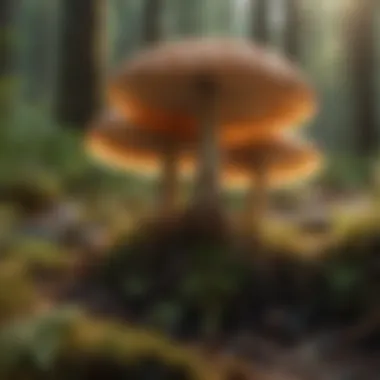
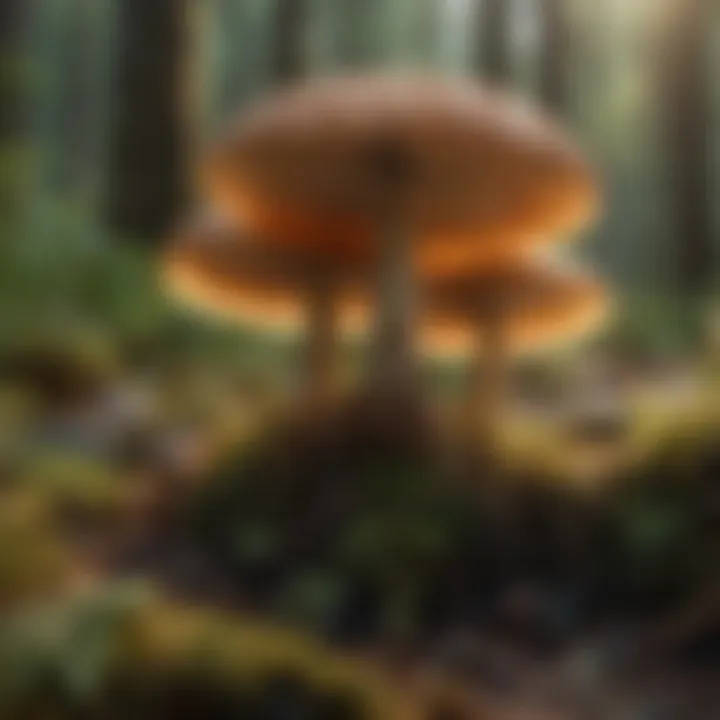
In essence, understanding these major fungal groups provides a solid foundation for identification and emphasizes the ecological interdependence that defines forest health.
Field Guides and Resources
Field guides and resources play a pivotal role in the identification of fungi, particularly for those navigating the dense foliage of American forests. Being able to distinguish between various fungi is not just an academic exercise; it’s fundamental for foragers, conservationists, and anyone with an interest in ecology. These guides provide an accessible way for individuals at all experience levels to enhance their knowledge and skills in fungal identification.
A quality field guide does much more than just list fungi with pictures; it offers a treasure trove of information that includes habitat preferences, seasonal appearances, and potential culinary advantages or dangers. For instance, engaging with these resources cultivates an ability to observe the subtle differences among similar species, laying the foundation for a responsible approach to foraging or studying fungi in their natural habitat.
Benefits of Using Field Guides
- Visual Identification: With numerous images and descriptions, field guides allow users to connect visual cues with their identified species, enhancing identification accuracy.
- Local Context: Many guides focus on specific regions, providing insights tailored to the local biodiversity encountered in American forests, which can vary significantly from one area to another.
- Safety Information: Recognizing the potential risk of poisoning from misidentifying edible fungi underscores the importance of reliable guides. Many guides include key safety tips, enabling individuals to confidently explore.
- Ecological Insights: Field guides often delve into the ecological roles of fungi, explaining their interactions within ecosystems, which is crucial knowledge for conservation efforts.
Recommended Field Guides
When it comes to selecting effective field guides, several stand out among the crowd:
- Mushrooms of North America by Andrew D. Parker: This guide is quite user-friendly and provides ample photographs alongside keys for identification, catering to both newbies and seasoned mycologists.
- The Audubon Society Field Guide to North American Mushrooms: Renowned for its comprehensive coverage, this book features over 700 species with stunning visuals and straightforward descriptions.
- Mushrooms Demystified by David Arora: This guide provides an in-depth exploration of mushrooms, with a mix of personal anecdotes and scientific information, helping to illuminate complex topics in an engaging manner.
Mobile Identification Apps
In today’s digital age, mobile apps supplement traditional field guides, offering convenience and real-time identification capabilities. This fusion of technology meets nature fosters an engaging user experience, allowing enthusiasts to document their findings on the spot. Users can snap pictures and receive instant feedback on their identifications, promoting a more interactive learning process.
Some notable mobile apps include:
- iNaturalist: This crowd-sourced app lets users submit photos of mushrooms and receive feedback from expert mycologists. It's ideal for not only identification but also sharing your findings with a larger community.
- Picture Mushroom: This app employs advanced recognition technology to help users identify mushrooms from images. With a comprehensive database, it can be a fantastic way to explore various species quickly.
- Mushroom Identificator: Tailored specifically for mushroom enthusiasts, this application specializes in recognizing different fungi based on a series of user-conducted queries and image recognition.
"Incorporating modern technology with traditional knowledge can enhance our experience and understanding in the field of mycology."
Embracing both field guides and digital resources cultivates a well-rounded approach to studying fungi. Whether you’re a budding enthusiast or a seasoned professional, these resources offer a necessary compass through the vast and complex world of fungi in American forests.
Common Misidentifications
Misidentification of fungi poses a significant challenge in both professional mycology and casual foraging. The importance of addressing this issue cannot be overstated, as it has direct implications for health, biodiversity, and conservation efforts. Misidentifications can lead to severe consequences, including the consumption of toxic species resulting in poisoning, or even fatalities. Moreover, incorrectly identified fungi can disrupt ecological research, skewing data that are essential for understanding ecosystems.
Understanding the pitfalls of misidentification is crucial for anyone working with or interested in fungi. Many factors contribute to misidentifications, including visual similarities between species, lack of experience, and the influence of cultural myths or misconceptions surrounding certain fungi.
Identifying Edible vs. Toxic Species
When it comes to foraging for mushrooms, the difference between edible and toxic species can often be a hair's breadth apart. Some species are so closely related that their distinguishing features are imperceptible to the untrained eye. For example, a common edible species like the Chanterelle can easily be confused with the toxic Jack-o’-lantern mushroom, both of which share a similar golden hue and a somewhat trumpet-shaped cap.
This highlights the importance of detailed identification steps:
- Know your species: Prior to any foraging, thoroughly study the fungi you are targeting, focusing on their specific features.
- Examine habitat: Different fungi often flourish in very particular habitats. Knowing where they thrive can assist in narrowing down options.
- Observe the gills: The structure and color of gills can differentiate toxic and edible varieties.
- Consult trusted sources: Field guides and expert advice can help in making accurate identifications.
While the thrill of discovering an edible mushroom is exhilarating, it is vital to proceed with caution and respect for the organism, ensuring that nothing toxic slips through the cracks.
The Role of Myths and Misconceptions
Cultural myths around mushrooms can have a profound impact on how they are perceived and, consequently, misidentified. Take the famous adage, "All mushrooms are edible, but some only once.” This whimsical saying encapsulates a dangerous misinformation that can lead to risky behavior.
Much of this stems from misunderstanding the nature of fungi and their ecological roles. For example, the belief that all mushrooms with a white cap are safe to consume has led more than a few novice foragers astray. The infamous Death Cap mushroom, which contains lethal toxins, sports a pristine white cap and grows in close quarters with many edible varieties. Thus, it’s crucial to challenge these myths, steering individuals towards more nuanced and informed perspectives on fungal diversity.
"Education is key; what you think you know can lead to peril if not truly understood."
Additionally, social media and online communities can perpetuate these misconceptions, spreading misinformation widely. Engaging with credible resources, joining local mycological societies, and opening discussions with experienced foragers can counter the influence of these myths.
Addressing misidentification not only enhances personal safety but contributes to the broader understanding of fungi’s role in ecosystems. It is through educating oneself and others that we can unravel the often murky world of fungi and appreciate their significance in nature.
Conservation Considerations
Conservation of fungi is often overshadowed by more charismatic plants and animals in the ecosystem. However, understanding the significance of fungi and actively working to preserve their habitats is crucial for maintaining biodiversity and ensuring the health of various ecosystems. Fungi play essential roles in nutrient cycling, symbiotic relationships with plants, and serving as food sources for a variety of organisms. Thus, prioritizing conservation considerations is paramount in fostering a balanced and robust ecosystem.
Impact of Climate Change on Fungal Biodiversity
The shifting climate has profound impacts on fungal biodiversity. Increased temperatures, changing precipitation patterns, and extreme weather events all influence fungal distribution and growth. Some species may thrive under warmer conditions while others could face extinction if their habitat becomes unsuitable.
- Shifts in Fungal Ranges: As temperatures rise, many fungi migrate towards higher altitudes or latitudes in search of suitable conditions. For example, certain mycorrhizal fungi, which are vital for plants’ nutrient uptake, could find themselves unable to adapt quickly enough to these changes, affecting entire plant communities.
- Altered Interactions: Climate change can disrupt the delicate balance of ecological relationships. This could lead to mismatched timing between fungi and their host plants, impacting plant health and growth.
- Disease Spread: Warmer temperatures may also create conducive environments for pathogenic fungi, leading to outbreaks that could threaten both plant and animal species. For instance, Batrachochytrium dendrobatidis, a chytrid fungus, has devastated frog populations worldwide and is believed to be exacerbated by climate-induced changes.
"Fungal communities are like the hidden backbone of the ecosystem; their health reflects the health of the surrounding environment."
Protecting Fungal Habitats
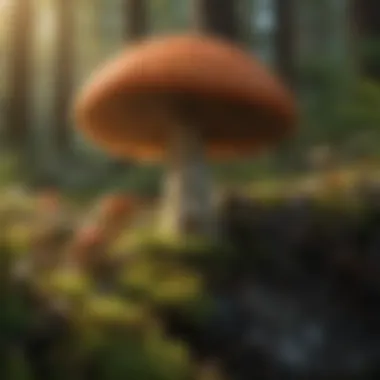
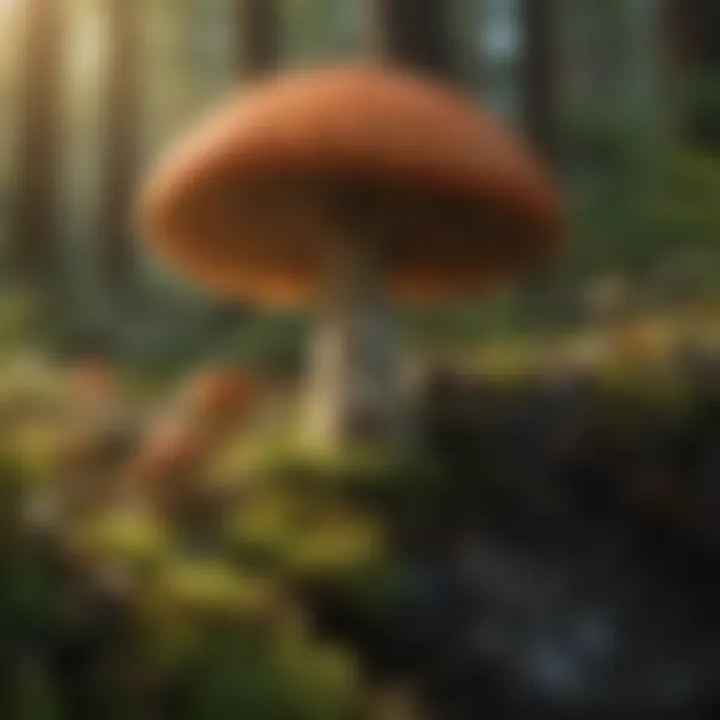
To conserve fungi effectively, it is vital to protect their habitats. Recognizing which ecosystems are most crucial for fungal growth is the first step. Forests, wetlands, and grasslands often harbor a rich diversity of fungi, and protecting these areas should be a primary objective for conservationists and forest managers alike.
- Habitat Preservation: Ensure that the natural integrity and biodiversity of ecosystems are maintained. This can involve safeguarding significant stands of trees, particularly old-growth forests, which provide unique habitats for a variety of fungal species.
- Minimizing Disturbance: Activities like logging, agriculture, and urban development can disrupt fungal habitats. Implementing sustainable practices that reduce soil compaction and maintain forest cover helps protect these delicate organisms.
- Restoration Efforts: In degraded areas, restoration ecology can play a vital role in reestablishing fungal communities. Reintroducing native plant species that form symbiotic relationships with fungi can help rekindle these essential connections.
- Public Awareness and Education: Educating the public about the importance of fungi in the ecosystem can foster a sense of stewardship. Community involvement in local conservation initiatives can greatly benefit fungal habitats.
In summary, recognizing the importance of conservation considerations related to fungi not only protects these organisms but also supports the broader ecosystem’s health. The more we understand about how our environment changes and the role fungi play, the better equipped we will be to take meaningful action towards conservation efforts.
Case Studies from American Forests
Studying fungi through case studies grants insight into their complex roles in forest ecosystems. These studies illuminate the unique characteristics of fungi that flourish in various habitats, while also showcasing their contributions to forest health. Understanding specific case studies enables us to appreciate the diversity of fungi and their relationships with other organisms.
Unique Fungal Species in Distinct Ecosystems
Each forest harbors an assortment of fungal species, many of which have adapted to thrive in specific ecological niches. For instance, the coastal redwood forests of California are home to the Amanita muscaria, known for its vibrant red cap and hallucinogenic properties. This species, while often recognized, plays a critical role in nutrient exchange within its habitat.
In contrast, the hardwood forests of the Eastern U.S. provide an environment for the Cortinarius speciosissimus, which helps decompose organic matter, enriching the soil. This particular fungus can be identified by its striking colors and large size, making it a captivating example of fungal diversity.
Importantly, these unique species not only contribute to their ecosystems through decomposition but also establish relationships with plants, aiding in nutrient uptake. The mutualistic associations between fungi and tree roots, especially with species like Lactarius indigo, can improve forest resilience against pathogens and environmental stresses.
Impact of Fungi on Forest Health
Fungi are vital players in maintaining forest health, significantly influencing biodiversity and ecological balance. One notable example comes from the mycorrhizal networks that fungi create underground. These networks facilitate communication and nutrient sharing among trees and plants, acting almost like a social network of the forest.
The existence of these mycorrhizal networks enhances forest stability by:
- Nutrient Cycling: They help break down organic matter, making nutrients available to trees. This functionality is particularly crucial in nutrient-poor soils, typical in certain forest regions.
- Disease Resistance: Fungi can also play a role in protecting trees from pathogens by outcompeting harmful microbes or triggering plant defenses.
- Water Retention: Many fungi assist in water absorption during dry spells, effectively acting as a sponge in challenging weather conditions.
"Understanding fungi and their role offers profound insights into forest dynamics, crucial for effective conservation efforts."
Overall, by examining the contributions of fungi documented in case studies, forestry professionals can develop more effective management strategies that promote biodiversity, aiding both natural ecosystems and agricultural practices. The continued exploration of fungi within these environments illuminates paths for future research and conservation efforts, proving that even the smallest organisms hold significant power in sustaining forest health.
Engaging with the Fungal Community
Connecting with the fungal community offers a window into the captivating world of mycology, elevating one’s understanding of fungi far beyond mere identification. Engagement not only enhances personal knowledge but also fosters a collective appreciation for the complexities of fungi within ecosystems. In participating in organized mycological activities, individuals become part of a network that advocates for fungal conservation and education, making a tangible impact on the wider ecological community.
Joining Local Mycological Societies
Being part of local mycological societies can be an enriching experience for both seasoned enthusiasts and novices. These groups serve as hubs for keen minds interested in fungi, organizing everything from educational workshops to field trips. Participating in such societies not only provides access to experienced mycologists but also opens doors to various resources, including curated field guides and identification workshops.
Benefits of joining a local mycological society include:
- Shared knowledge and experiences
- Networking opportunities with fellow mycophiles
- Access to exclusive foraging events and lectures
- Participation in conservation initiatives
Moreover, there’s an undeniable advantage in having a wealth of collective knowledge at one’s disposal. Experienced members often share their insights about specific local taxa or environmental factors influencing fungal growth. One can glean such knowledge that books or online resources may not fully capture.
Participating in Fungi Foraging Events
Fungi foraging events offer a unique, hands-on approach to understanding the nuances of identification. Enthusiasts gather to explore various habitats while learning from seasoned foragers and mycologists. These events embody a rich blend of education, camaraderie, and thrill—a practical exercise in real-world identification. The sheer act of rummaging through leaf litter or inspecting decaying logs makes the information come alive, creating memorable learning experiences.
"Foraging is not merely about finding edible mushrooms; it fosters respect for the ecosystems where they thrive."
Key considerations for attending such foraging events include:
- Understanding local regulations about foraging
- Being prepared with necessary tools such as knives, baskets, and field guides
- Developing a keen eye for distinguishing subtle differences in mushroom morphology
Engaging with the fungal community through these events helps not only in identifying mushrooms but also in appreciating their ecological roles. Participants often walk away with a better sense of environmental stewardship, understanding that fungi play crucial roles in nutrient cycling and habitat stability.
Future Directions in Mycology
The ever-evolving field of mycology holds a treasure trove of future directions that can enhance our understanding of fungi and their roles in various ecosystems. Research trends are rapidly shifting, prompted by new technologies, global environmental changes, and a growing awareness of fungal significance. Embracing these future directions not only encourages continued exploration within mycology but also underscores the essential contributions fungi make to our world. As we look ahead, it is crucial to acknowledge the myriad of benefits that multidisciplinary approaches can provide, ranging from improved ecological insight to applications in biotechnology.
Emerging Fungal Research Trends
One area that has garnered considerable attention is the intersection of genomics and mycology. The advent of genomic technologies offers the ability to delve into the genetic makeup of various fungi, unveiling hidden relationships and evolutionary patterns. Some specific trends include:
- Metagenomics, which enables scientists to study fungi within complex environmental samples, shedding light on biodiversity that often goes unnoticed.
- Fungal phylogenomics, a crucial tool for constructing the tree of life, helping clarify the evolutionary descent of different fungal species.
- Mycorrhizal research, exploring how fungi form symbiotic relationships with plants and the resulting implications for agriculture and natural ecosystems.
Through these research avenues, mycologists can better comprehend fungal responses to environmental pressures and how changes in climate influence their populations—an understanding critical for conservation efforts and ecosystem management.
The Role of Citizen Science
Citizen science has also emerged as a pivotal element in the study of fungi. Increasingly, amateurs and enthusiasts are contributing valuable data, expanding our knowledge base on a global scale. This grassroots involvement is fostering a culture of sharing and collaboration that is tremendously beneficial. Some essential aspects include:
- Data Collection: Local communities can assist in identifying and cataloging fungal species, providing critical information on distribution and population trends.
- Awareness and Education: Engaging the public through workshops and foraging events enhances knowledge about fungi, building deeper connections to nature and conservation efforts.
- Conservation Advocacy: Citizen science initiatives often drive awareness of environmental issues surrounding fungi, leading to collective action for habitat protection.
By empowering individuals to participate in scientific processes, we cultivate a more informed public that values and understands the complexity of fungal life.
As future research unfolds, the symbiotic relationship between professional scientists and citizen scientists will only strengthen, contributing to a well-rounded understanding of mycology and fostering appreciation for the myriad functions fungi serve in our ecosystems.



